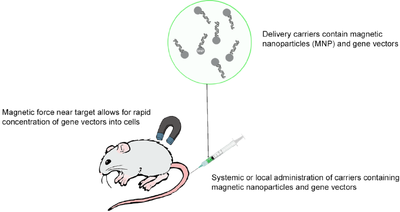Superparamagnetic Iron Oxide Nanoparticle
(industrial material, nanoparticle, nanomedicine) | |
|---|---|
 | |
| SPIONS have aroused significant interest as delivery system of biotherapeutics (therapeutic cells, proteins and genes). |
Superparamagnetic iron oxide nanoparticles (SPIONs) comprise a promising field within the emerging field of nanomedicine[1] They have attracted extensive interest due to their superparamagnetic properties and their potential applications in many fields.
SPION-based materials can be ideal candidates for developing therapeutic cells, proteins and gene delivery systems because of their excellent biocompatibility and superparamagnetism that enables long-term accumulation/retention at target sites by utilization of a suitable magnet. [2]
SPIONS are iron oxide particles with diameters between about 1 and 100 nanometers (although cobalt and nickel are also highly magnetic materials, they are toxic and easily oxidized). Iron oxide is easily degradable and therefore useful for in vivo (live subjects) applications.
Applications of iron oxide nanoparticles include separation of biomolecules, and targeted drug and gene delivery for medical diagnosis and therapeutics. SPION-based carrier systems have many advantages over other nanoparticle-based systems. They are biocompatible, biodegradable, easily tunable, and superparamagnetic and thus controllable by an external magnetic field. In particular, magnetically-driven carriers are drawing considerable interest as an emerging therapeutic delivery system because of their superior delivery.[2]
Given the desirable features SPIONS can be targeted, controlled and monitored to optimize the required therapeutically measures. However, as of 2020, the toxicity concerns have prevented adoption of them in clinical treatments.[3]
Biomedical applications
SPIONS have attracted much attention because studies have associated with low toxicity in the human body; however by 2020, the research was still ongoing, as the toxicity depends on numerous factors, e.g., size, shape, structure, surface modification, concentration, dosage, biodistribution, solubility, immunogenicity[3] and also "subtle cellular alterations in the form of DNA damage and oxidative stress".[4]. The large surface to volume ratio may favor interactions within various bodily components, if inhaled, absorbed or swallowed, also, the ability to cross cell barriers and resistance to biodegradation increase the toxic potential of these nano-entities.[3]

Other applications of iron oxide nanoparticles include terabit magnetic storage devices, catalysis, sensors, superparamagnetic relaxometry, high-sensitivity biomolecular magnetic resonance imaging, magnetic particle imaging, magnetic fluid hyperthermia, separation of biomolecules, and targeted drug and gene delivery for medical diagnosis and therapeutics.
References
- ↑ https://pubmed.ncbi.nlm.nih.gov/22934920/
- ↑ Jump up to: a b https://www.ncbi.nlm.nih.gov/pmc/articles/PMC4167583/
- ↑ Jump up to: a b c https://www.ncbi.nlm.nih.gov/pmc/articles/PMC7397295/
- ↑ https://www.ncbi.nlm.nih.gov/pmc/articles/PMC3215220/
- ↑ https://www.sciencedirect.com/science/article/pii/S0168365920300171